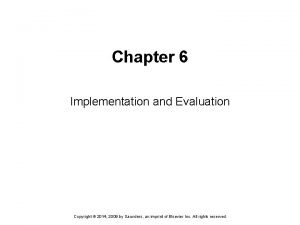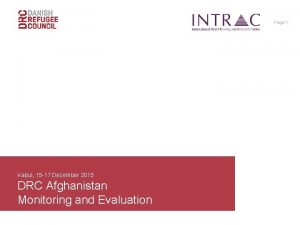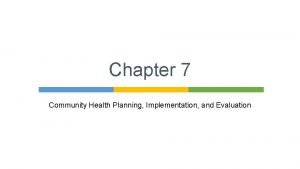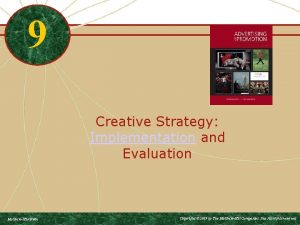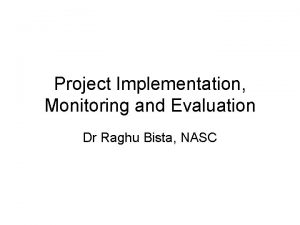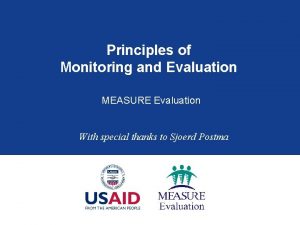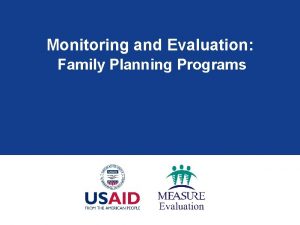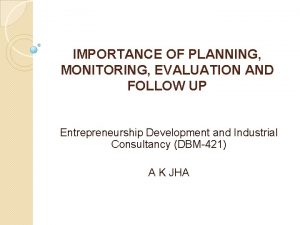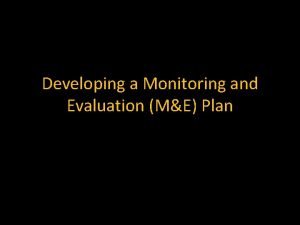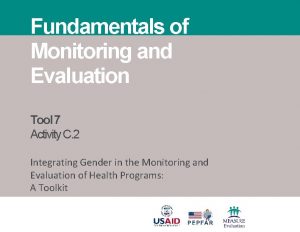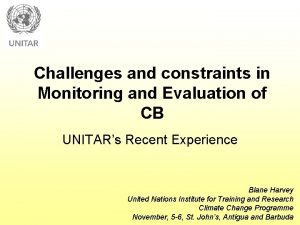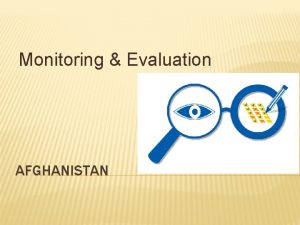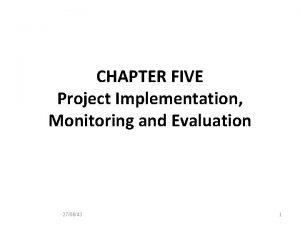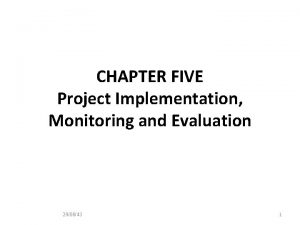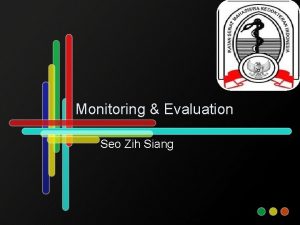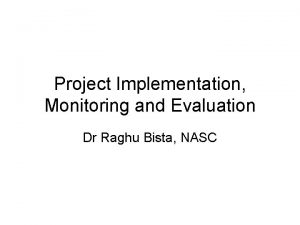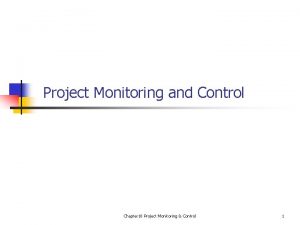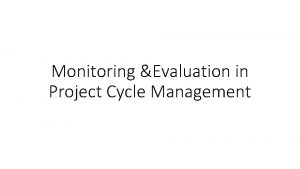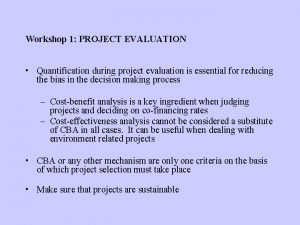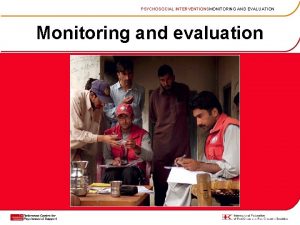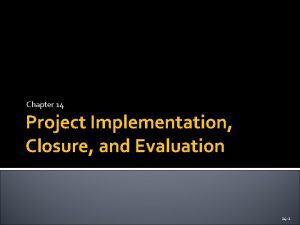Chapter 4 Project Implementation Monitoring and Evaluation Monitoring























- Slides: 23

Chapter- 4: Project Implementation, Monitoring and Evaluation ØMonitoring and Evaluation • Monitoring and evaluation are essential management tools which help to ensure that project activities are implemented as planned and to assess whether desired results are being achieved.

Cont… • Monitoring is a process of measuring, recording, collecting and analyzing data on actual implementation of the project and communicating it to the project managers. • So that any deviation from the planned operations are detected, analysis for causes of deviation is carried out and suitable corrective actions are taken.

Cont… § Monitoring is a long-term / on going process in order to ensure whether activities are taking place according to standards and to find out weaknesses within the project. § Monitoring is activity based. • Monitoring is the continuous, systematic and critical review of operations in order to measure their evolution and adjust them according to circumstances and project’s objectives.

Cont… § The purpose of monitoring are to; Øprovide concurrent feedback on the progress of activities ØIdentify the problems in their implementation ØTo promote accountability* to all stakeholders of a project (project agents , donors, etc) and to take corrective action

Cont… ØThus in the process of Monitoring; üAny deviations from plans would be detected üThe causes for deviations would be Identified üCorrective action would be taken

o Different steps of project’s monitoring • . . 3 1 The project 2 Collecting data 4 Processing/A rranging data Taking decisions Analysis Taking corrective action 5

Cont… § Evaluation: is after the end or at mid-term of the Project to find out the weakness and the results of the project. ØIt is a systematic way of learning from experience and using the lessons learnt to improve current activities and promote better planning by careful selection of alternatives for future action.

Cont…. § Evaluation can be used as a point of reference for future projects. § Evaluation involves external people. § Evaluation is a one or two time event (always happens at the end of the project). § Evaluation is result based ; measures the results through indicators.

Cont… • Evaluation involves the same skills as assessment and analysis. • Evaluation should be done neutrally and preferably by external staff. • One of the most important sources of information for evaluations may be data used for monitoring.

v Reasons for carrying out an Evaluation • To review the implementation of and services provided by project so as to identify problems. • To document results achieved by a project funded by donor agencies. • To know whether desired outcomes are being achieved and identify remedial measures. • To assess whether the desired results of a project have been achieved

Cont…

v Types of Evaluation • Formative • “Improve” • Periodic and timely • Focus on project activities and outputs • Leads to early recommendations for project improvement • Summative • “Prove” • Focus on outcomes and impact

v Process of Evaluation § The process of evaluation consists of the following components: 1. Specify the particular subjects 2. Information support 3. Verify relevance 4. Assess adequacy 5. Review progress 6. Assess efficiency (cost - effectiveness) 7. Assess effectiveness

Chapter 5: Evaluation; Basics of impact evaluation ØWhat is impact evaluation? • By ‘impact’ we mean the broad or longer-term effects of a project. • This can include effects on people who are direct users of a project, effects on those who are not direct users, or effects on a wider field such as government policy.

Cont… • Impact evaluation is an effort to understand whether the changes in well-being are indeed due to project intervention. • Specifically, impact evaluation tries to determine whether it is possible to identify the project effect and to what extent the measured effect can be attributed to the project and not to some other causes.

Cont… • The basic organizing principle for any good evaluation of an intervention is to ask the question: what would have happened in the absence of the intervention? or • What would have been the welfare levels of particular communities, groups, households and individuals without the intervention?

v Quantitative versus Qualitative Impact Assessments • Governments, donors, and other practitioners in the development community are intense to determine the effectiveness of project with far-reaching goals such as lowering poverty or increasing employment. • These policy missions are often possible only through impact evaluations based on hard evidence from survey data or through related quantitative approaches.

Cont… • Qualitative: Qualitative information such as understanding the local sociocultural context, and participant details. • Qualitative information can help to identify mechanisms through which project might be having an impact.

Cont… • Quantitative: quantitative information that is important in addressing potential statistical bias in project impacts. • Therefore , a mixture of qualitative and quantitative methods (a mixed-methods approach) are useful in gaining comprehensive view of the project’s effectiveness. a

o Quantitative Impact Assessment: Ex post versus Exante Impact Evaluation • There are two types of quantitative impact evaluations: ex post and ex ante. • An ex ante impact evaluation attempts to measure the intended impacts of future project, given a potentially targeted area’s current situation.

Cont… • Many times, ex ante evaluations are based on structural models of the economic environment facing potential participants. • The underlying assumptions of structural models, for example, involve identifying the main economic agents in the development of the project (individuals, communities, local or national governments).

Cont… • These models predict project impacts. • Ex post evaluations, in contrast, measure actual impacts accrued by the beneficiaries that are attributable to project intervention.

v Methodologies in impact evaluation 1. Randomizations Reading assignment 2. Matching methods
 Chapter 6 implementation and evaluation
Chapter 6 implementation and evaluation Project monitoring cycle
Project monitoring cycle Differentiate monitoring from evaluation
Differentiate monitoring from evaluation Example of monitoring and evaluation in project proposal
Example of monitoring and evaluation in project proposal Objectives of evaluation
Objectives of evaluation Hrd program implementation and evaluation
Hrd program implementation and evaluation Community health planning and implementation certificate
Community health planning and implementation certificate Transformational ad
Transformational ad Software project evaluation
Software project evaluation Pregnancy and infant cohort monitoring and evaluation
Pregnancy and infant cohort monitoring and evaluation Comparison between monitoring and evaluation
Comparison between monitoring and evaluation What are the principles of monitoring and evaluation
What are the principles of monitoring and evaluation Monitoring and evaluation dashboard
Monitoring and evaluation dashboard Monitoring and evaluation of family planning programs
Monitoring and evaluation of family planning programs Knowledge management monitoring and evaluation
Knowledge management monitoring and evaluation Importance of planning, monitoring and evaluation
Importance of planning, monitoring and evaluation Me plan
Me plan Principles of monitoring and evaluation
Principles of monitoring and evaluation Basics of monitoring and evaluation
Basics of monitoring and evaluation Unitar united nations
Unitar united nations Centre for evaluation and monitoring
Centre for evaluation and monitoring Advocacy process 8 steps
Advocacy process 8 steps Budget monitoring and evaluation
Budget monitoring and evaluation Monitoring and evaluation image
Monitoring and evaluation image
